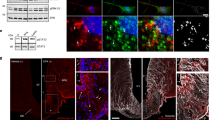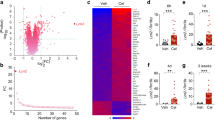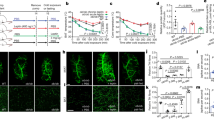Abstract
Leptin (encoded by Lep) controls body weight by regulating food intake and fuel partitioning. Obesity is characterized by leptin resistance and increased endocannabinoid tone. Here we show that leptin infused into the mediobasal hypothalamus (MBH) of rats inhibits white adipose tissue (WAT) lipogenesis, which occurs independently of signal transducer and activator of transcription-3 (STAT3) signaling. Correspondingly, transgenic inactivation of STAT3 signaling by mutation of the leptin receptor (s/s mice) leads to reduced adipose mass compared to db/db mice (complete abrogation of leptin receptor signaling). Conversely, the ability of hypothalamic leptin to suppress WAT lipogenesis in rats is lost when hypothalamic phosphoinositide 3-kinase signaling is prevented or when sympathetic denervation of adipose tissue is performed. MBH leptin suppresses the endocannabinoid anandamide in WAT, and, when this suppression of endocannabinoid tone is prevented by systemic CB1 receptor activation, MBH leptin fails to suppress WAT lipogenesis. These data suggest that the increased endocannabinoid tone observed in obesity is linked to a failure of central leptin signaling to restrain peripheral endocannabinoids.
This is a preview of subscription content, access via your institution
Access options
Subscribe to this journal
Receive 12 print issues and online access
$209.00 per year
only $17.42 per issue
Buy this article
- Purchase on Springer Link
- Instant access to full article PDF
Prices may be subject to local taxes which are calculated during checkout






Similar content being viewed by others
References
Bluher, M. et al. Dysregulation of the peripheral and adipose tissue endocannabinoid system in human abdominal obesity. Diabetes 55, 3053–3060 (2006).
Matias, I. et al. Regulation, function, and dysregulation of endocannabinoids in models of adipose and β-pancreatic cells and in obesity and hyperglycemia. J. Clin. Endocrinol. Metab. 91, 3171–3180 (2006).
Woods, S.C. The endocannabinoid system: mechanisms behind metabolic homeostasis and imbalance. Am. J. Med. 120, S9–S17 (2007).
Barzilai, N. et al. Leptin selectively decreases visceral adiposity and enhances insulin action. J. Clin. Invest. 100, 3105–3110 (1997).
Halaas, J.L. et al. Physiological response to long-term peripheral and central leptin infusion in lean and obese mice. Proc. Natl. Acad. Sci. USA 94, 8878–8883 (1997).
Shimabukuro, M. et al. Direct antidiabetic effect of leptin through triglyceride depletion of tissues. Proc. Natl. Acad. Sci. USA 94, 4637–4641 (1997).
Wang, M.Y., Lee, Y. & Unger, R.H. Novel form of lipolysis induced by leptin. J. Biol. Chem. 274, 17541–17544 (1999).
Muzumdar, R. et al. Physiologic effect of leptin on insulin secretion is mediated mainly through central mechanisms. FASEB J. 17, 1130–1132 (2003).
Fan, W. et al. The central melanocortin system can directly regulate serum insulin levels. Endocrinology 141, 3072–3079 (2000).
Buettner, C. et al. Critical role of STAT3 in leptin's metabolic actions. Cell Metab. 4, 49–60 (2006).
Saha, A.K. et al. Malonyl-CoA regulation in skeletal muscle: its link to cell citrate and the glucose-fatty acid cycle. Am. J. Physiol. 272, E641–E648 (1997).
Potapova, I.A., El Maghrabi, M.R., Doronin, S.V. & Benjamin, W.B. Phosphorylation of recombinant human ATP:citrate lyase by cAMP-dependent protein kinase abolishes homotropic allosteric regulation of the enzyme by citrate and increases the enzyme activity. Allosteric activation of ATP:citrate lyase by phosphorylated sugars. Biochemistry 39, 1169–1179 (2000).
Wang, M.Y., Orci, L., Ravazzola, M. & Unger, R.H. Fat storage in adipocytes requires inactivation of leptin's paracrine activity: Implications for treatment of human obesity. Proc. Natl. Acad. Sci. USA 102, 18011–18016 (2005).
Zvonic, S., Baugh, J.E. Jr., Arbour-Reily, P., Mynatt, R.L. & Stephens, J.M. Cross-talk among gp130 cytokines in adipocytes. J. Biol. Chem. 280, 33856–33863 (2005).
Tabor, D.E., Kim, J.B., Spiegelman, B.M. & Edwards, P.A. Transcriptional activation of the stearoyl-CoA desaturase 2 gene by sterol regulatory element–binding protein/adipocyte determination and differentiation factor 1. J. Biol. Chem. 273, 22052–22058 (1998).
Cohen, P. et al. Role for stearoyl-CoA desaturase-1 in leptin-mediated weight loss. Science 297, 240–243 (2002).
Soukas, A., Cohen, P., Socci, N.D. & Friedman, J.M. Leptin-specific patterns of gene expression in white adipose tissue. Genes Dev. 14, 963–980 (2000).
Spiegelman, B.M., Puigserver, P. & Wu, Z. Regulation of adipogenesis and energy balance by PPARγ and PGC-1. Int. J. Obes. Relat. Metab. Disord. 24 Suppl. 4, S8–S10 (2000).
Kersten, S. Mechanisms of nutritional and hormonal regulation of lipogenesis. EMBO Rep. 2, 282–286 (2001).
Yamauchi, T. et al. The mechanisms by which both heterozygous peroxisome proliferator-activated receptor γ (PPARγ) deficiency and PPARγ agonist improve insulin resistance. J. Biol. Chem. 276, 41245–41254 (2001).
Kageyama, H. et al. Lipoprotein lipase mRNA in white adipose tissue but not in skeletal muscle is increased by pioglitazone through PPAR-γ. Biochem. Biophys. Res. Commun. 305, 22–27 (2003).
Schweiger, M. et al. Adipose triglyceride lipase and hormone-sensitive lipase are the major enzymes in adipose tissue triacylglycerol catabolism. J. Biol. Chem. 281, 40236–40241 (2006).
Zimmermann, R. et al. Fat mobilization in adipose tissue is promoted by adipose triglyceride lipase. Science 306, 1383–1386 (2004).
Reshef, L. et al. Glyceroneogenesis and the triglyceride/fatty acid cycle. J. Biol. Chem. 278, 30413–30416 (2003).
Reidy, S.P. & Weber, J. Leptin: an essential regulator of lipid metabolism. Comp. Biochem. Physiol. A Mol. Integr. Physiol. 125, 285–298 (2000).
Anthonsen, M.W., Ronnstrand, L., Wernstedt, C., Degerman, E. & Holm, C. Identification of novel phosphorylation sites in hormone-sensitive lipase that are phosphorylated in response to isoproterenol and govern activation properties in vitro. J. Biol. Chem. 273, 215–221 (1998).
Greenberg, A.S. et al. Stimulation of lipolysis and hormone-sensitive lipase via the extracellular signal–regulated kinase pathway. J. Biol. Chem. 276, 45456–45461 (2001).
Bates, S.H. et al. STAT3 signalling is required for leptin regulation of energy balance but not reproduction. Nature 421, 856–859 (2003).
Bates, S.H., Kulkarni, R.N., Seifert, M. & Myers, M.G. Jr. Roles for leptin receptor/STAT3-dependent and -independent signals in the regulation of glucose homeostasis. Cell Metab. 1, 169–178 (2005).
Osei-Hyiaman, D. et al. Endocannabinoid activation at hepatic CB1 receptors stimulates fatty acid synthesis and contributes to diet-induced obesity. J. Clin. Invest. 115, 1298–1305 (2005).
Despres, J.P., Golay, A. & Sjostrom, L. Effects of rimonabant on metabolic risk factors in overweight patients with dyslipidemia. N. Engl. J. Med. 353, 2121–2134 (2005).
Pi-Sunyer, F.X., Aronne, L.J., Heshmati, H.M., Devin, J. & Rosenstock, J. Effect of rimonabant, a cannabinoid-1 receptor blocker, on weight and cardiometabolic risk factors in overweight or obese patients: RIO-North America: a randomized controlled trial. J. Am. Med. Assoc. 295, 761–775 (2006).
Di Marzo, V. et al. Leptin-regulated endocannabinoids are involved in maintaining food intake. Nature 410, 822–825 (2001).
Jo, Y.H., Chen, Y.J., Chua, S.C. Jr., Talmage, D.A. & Role, L.W. Integration of endocannabinoid and leptin signaling in an appetite-related neural circuit. Neuron 48, 1055–1066 (2005).
Gonthier, M.P. et al. Identification of endocannabinoids and related compounds in human fat cells. Obesity (Silver Spring) 15, 837–845 (2007).
Cota, D. et al. The endogenous cannabinoid system affects energy balance via central orexigenic drive and peripheral lipogenesis. J. Clin. Invest. 112, 423–431 (2003).
Cousin, B. et al. Local sympathetic denervation of white adipose tissue in rats induces preadipocyte proliferation without noticeable changes in metabolism. Endocrinology 133, 2255–2262 (1993).
Youngstrom, T.G. & Bartness, T.J. White adipose tissue sympathetic nervous system denervation increases fat pad mass and fat cell number. Am. J. Physiol. 275, R1488–R1493 (1998).
Giordano, A. et al. White adipose tissue lacks significant vagal innervation and immunohistochemical evidence of parasympathetic innervation. Am. J. Physiol. Regul. Integr. Comp. Physiol. 291, R1243–R1255 (2006).
Kreier, F. & Buijs, R.M. Evidence for parasympathetic innervation of white adipose tissue, clearing up some vagaries. Am. J. Physiol. Regul. Integr. Comp. Physiol. 293, R548–R549 (2007).
de Luca, C. et al. Complete rescue of obesity, diabetes, and infertility in db/db mice by neuron-specific LEPR-B transgenes. J. Clin. Invest. 115, 3484–3493 (2005).
Guo, K. et al. Disruption of peripheral leptin signaling in mice results in hyperleptinemia without associated metabolic abnormalities. Endocrinology 148, 3987–3997 (2007).
Niswender, K.D. et al. Intracellular signalling. Key enzyme in leptin-induced anorexia. Nature 413, 794–795 (2001).
Cota, D. et al. Hypothalamic mTOR signaling regulates food intake. Science 312, 927–930 (2006).
Metlakunta, A.S., Sahu, M. & Sahu, A. Hypothalamic phosphatidylinositol 3-kinase pathway of leptin signaling is impaired during the development of diet-induced obesity in FVB/N mice. Endocrinology 149, 1121–1128 (2008).
Wang, Z.W. et al. Hyperleptinemia depletes fat from denervated fat tissue. Biochem. Biophys. Res. Commun. 260, 653–657 (1999).
Rooks, C.R. et al. Sympathetic denervation does not prevent a reduction in fat pad size of rats or mice treated with peripherally administered leptin. Am. J. Physiol. Regul. Integr. Comp. Physiol. 289, R92–R102 (2005).
Ruderman, N.B. et al. Interleukin-6 regulation of AMP-activated protein kinase: potential role in the systemic response to exercise and prevention of the metabolic syndrome. Diabetes 55, S48–S54 (2006).
Bouaboula, M. et al. Anandamide induced PPARγ transcriptional activation and 3T3–L1 preadipocyte differentiation. Eur. J. Pharmacol. 517, 174–181 (2005).
Pagano, C. et al. The endogenous cannabinoid system stimulates glucose uptake in human fat cells via PI3-kinase– and calcium-dependent mechanisms. J. Clin. Endocrinol. Metab. 92, 4810–4819 (2007).
Acknowledgements
We wish to thank B. Liu, S. Gaveda and C. Baveghems for technical assistance, S. Chua for helpful discussions and M. Myers (University of Michigan, Ann Arbor) for the s/s mice. Some of the db/db mice were a gift from R. Harris (University of Georgia, Athens). This work was supported by grants to L.R. (NIH DK048321), C.B. (NIH DK074873) and G.J.S. (NIH DK066618) from the US National Institutes of Health, the Skirball Institute for Nutrient Sensing and the New York Obesity Research Center (NIH DK026687). C.B. is the recipient of a Junior Faculty Award and E.D.M. is the recipient of a Physician Scientist Training Award, both from the American Diabetes Association.
Author information
Authors and Affiliations
Contributions
E.D.M performed qPCR (Fig. 2), A.C. performed qPCR and western blots (Fig. 2), L.C. assisted with western blots and qPCR (Figs. 4 and 5 and Supplementary Figs. 1,3 and 4), T.S. performed western blots (Figs. 5 and 6), A.P. performed and supervised clamp studies (Fig. 2), K.S. carried out MBH infusions and western blots (Fig. 3 and 5), B.C. performed some of the clamp studies (Fig. 5), J.H.-W. measured endocannabinoid and catecholamine levels, X.L. performed denervations, G.J.S. performed 6-OHDA injections, denervations and designed experiments (Fig. 5 and Supplementary Figs. 3 and 4), G.K. analyzed endocannabinoid and catecholamine levels and designed experiments (Fig. 4 and Supplementary Figs. 2 and 3), L.R. designed experiments (Figs. 1 – 3), and C.B. designed and performed experiments, supervised experimentation, analyzed the data, coordinated the project and wrote the manuscript.
Corresponding authors
Supplementary information
Supplementary Text and Figures
Supplementary Figs. 1–4 and Supplementary Methods (PDF 2622 kb)
Rights and permissions
About this article
Cite this article
Buettner, C., Muse, E., Cheng, A. et al. Leptin controls adipose tissue lipogenesis via central, STAT3–independent mechanisms. Nat Med 14, 667–675 (2008). https://doi.org/10.1038/nm1775
Received:
Accepted:
Published:
Issue Date:
DOI: https://doi.org/10.1038/nm1775
This article is cited by
-
Murine leukemia virus (MLV) P50 protein induces cell transformation via transcriptional regulatory function
Retrovirology (2023)
-
Endothelial cell-derived stem cell factor promotes lipid accumulation through c-Kit-mediated increase of lipogenic enzymes in brown adipocytes
Nature Communications (2023)
-
Metabolic Messengers: endocannabinoids
Nature Metabolism (2022)
-
Brain insulin signalling in metabolic homeostasis and disease
Nature Reviews Endocrinology (2021)
-
Leptin brain entry via a tanycytic LepR–EGFR shuttle controls lipid metabolism and pancreas function
Nature Metabolism (2021)



